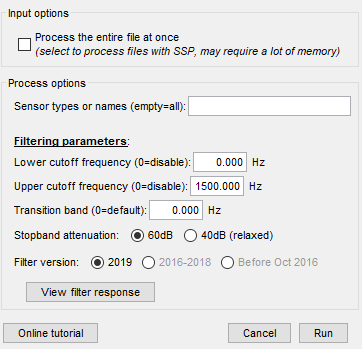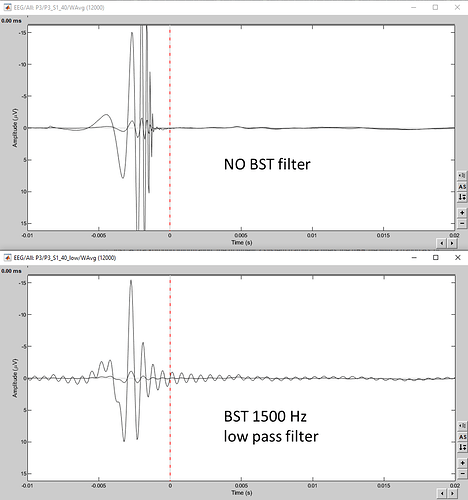Hello BST community,
I was pre-processing an ABR data (.BDF file) acquired from BioSemi Actiview 2 system.
Just as background information, the ActiView 2 system hardware filters the ABR file with a bandpass of 100 - 3300 Hz when saving. The ABR channels (Left and Right) are already referenced to the reference channel at saving therefore there is no need for re-referencing through Brainstorm process.
In my pre-processing pipeline, the below settings were used to filter my data.

In the below two images, the top represents the averaged response (6000 ABR epochs; the response is actually the stimulus artifact) without Brainstorm filtering and the bottom represents the same response with Brainstorm filtering (LP 1500 Hz). The two images differ ONLY by the filtering processing applied.
Interestingly, the bottom is now showing some kind of filter "ringing" response (?) which is not shown in the top image. What I need is Brainstorm to correctly process the LP 1500 Hz filter without the problematic filtering issue shown in the bottom image.
What might be going on here? Any thoughts?
Your epoch is only 30ms long, which might be causing the issue. Try applying the filter on the continuous recording or increase the epoch length so that it is larger than the filter’s response, which you can see by clicking in the View Filter Response button in the filter process window.
Thanks for your response Sylvain.
I've tried both methods that you've mentioned; applying the filter on the continuous recording and extending the epoch lengths; both methods do not seem to work. The filter ringing issue also occurs when using a visualisation filter on a non-filtered recording.
I should point out that I've been using this same set of filter settings for some time with all of my other studies which also utilize ABRs without any issues (same epoch length 30 ms with application of the filter setting on the continuous recording). This filter ringing issue seems to be present with this particular recording only. The only important difference that I can think of that is different in this particular recording is the presence of an obvious stimulus artifact. However, the presence of the stimulus artifact still does not explain the filter ringing that I'm seeing.
Therefore there must be something else going on that is specific to this recording which I am not sure about.
Thank you!
Would you mind sharing the time series, please, so that we can investigate on our end?
Also, where do you see the artifact you mentioned? please provide a screen shot with an annotation.
Keep in mind that visualization filters (Filter tab) are not applied to the entire data, but only to the data that is displayed, thus they edge effects are introduced. This effects will look the same as filtering an epoch of the length of the displayed data.
Can you share a screenshot with the filter response (View filter response button)?
Thank you @Sylvain and @Raymundo.Cassani
I wish to give you more information about the issues that I am facing.
We are currently using the Biosemi Actiview2 system to collect some ABRs.
Left bipolar channel is the ABR response from air conduction (AC) stimulus delivered by insert earphone commonly used in an audiology practice.
Right bipolar channel is the ABR response from bone conduction (BC) stimulus delivered by a bone conductor/vibrator also commonly used in an audiology practice.
When Actiview saves the ABR files into "BDF" file, the files are hardware filtered to 100 - 3300 Hz.
Therefore applying Brainstorm LP filter @ 1500 Hz in effect changes the filter setting from 100 - 1500 Hz.
Due to the placement of the insert earphone and the bone conductor and the placement of the Biosemi active electrodes picking up the stimulus artifacts (shown below) is inevitable.
The below shows the before and after images of applying the Brainstorm LP 1500 Hz filter to the raw continuous recording. The green vertical line indicates a trigger impulse to represent the delivery of a sound stimulus (we used the chirp). As you can see compared to the top figure the bottom figure's stimulus artifact is very different due to the application of LP 1500 Hz filter.
After we epoch the data and then average the epochs the below happens (also attached is the filter response). The first is the zoomed-out version of the second figure. You can see that due to the filter ringing, in the second figure, ABRs are pretty much not there or not identifiable. Note that you will always expect a larger stimulus artifact from the right channel as this is from bone conductor and the electrode is much closer to the bone conductor compared to the insert earphone (air conductor).
The results seen above are perplexing indeed because if you look at the exact same data but through ActiRead (which is a BDF file reader published by Biosemi) you do not see the ABR distortion.
We think all these issues are due to the interaction between the stimulus artifact and the LP filter applied but unsure specifically what exactly might be going on. Therefore I attach here the same raw BDF file that we've been using to investigate this interesting observation - hope you find the data useful for investigation.
In this BDf file, the channels labelled "Left" and "Right" are the bipolar channels that require investigation. "Lmon" and "Rmon" are monopolar channels.
https://1drv.ms/u/s!As4IRY9w_NZHzCHdE2TZ6Fsd98fE?e=JfD8hY
1 Like
Thank you for the detailed report and for sharing the raw recordings.
The oscillations that you are seen is in fact the response of the filter to the stimulus artifact. As you can see in the filter design, the filter length 59k+ samples, so the transient (ringing) of the response of the stimulus artifact distorts the part of the signal you are interested.
A way to solve this is by using a filter with a less sharp transition band (and less attenuation). For example: Transition band of 300 Hz, and Stopband attenuation of 40dB.

Such a filter has a length of 122 samples, full transient of 3.7 ms, thus filtering parts of the signal away of the stimulus artifact for at least 3.7ms will not be affected by the response of the filter to the stimulus artifact.
1 Like
Wonderful  Thank you very much for this suggestion!
Thank you very much for this suggestion!
This has worked very well - thank you for your time spent on this matter.









